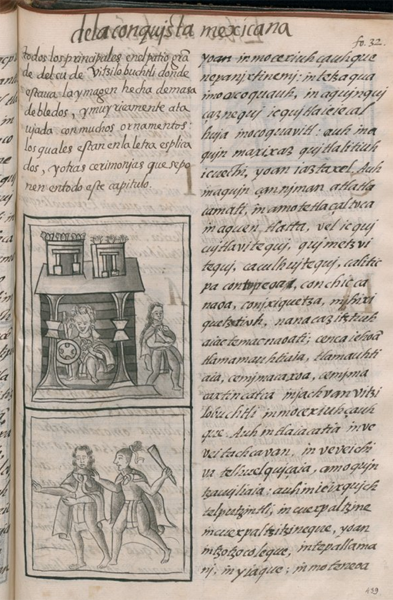Folio 32 recto
Translations and Transcriptions
Spanish Translation
[Translation of the Nahuatl into Spanish by Fr. Bernardino de Sahagún; transcription of the Spanish (left-hand column) by James Lockhart:] [f. 32r.] todos los principales en el patio grāde del cu de Vitzilobuchtli donde estaua la ymagen hecha de masa de bledos, y muy ricamente atauiada con muchos ornamentos: los quales estan en la letra esplicados, y otras cerimonias que se ponen en todo este capitulo.
English Translation
[Translation of the Nahuatl (right-hand column) by James Lockhart:]
those who had fasted for a year
Analytic Transcription
[Transcription of the Nahuatl (right-hand column) by James Lockhart:] [f. 32r.] yoan in mocexiuhçauhque nepanixtinemi: in tetzaqua imoocoquauh, in aquinquiçaznequi ic quitlaieiecalhuia in ocoquavitl: auh inaquin maxixaz quitlalitiuh icuechi,* yoan iaztaxel. Auh in aquin çan niman atlatlacamati, in amo tetlaçaltoca in aquen tlatta, vel ic quicuitlavitequi, quimetzvitequi,caculhuitequi, caliticpa contopeoa, conchiccanaoa, conixiquetza, mihixiquetztiuh, nanacazitztiuh aiac temac naoati; cenca iehoā tlamamauhtiaia, tlamauhtiaia, cemima-caxoa, cemimacaxtin catca in iachvan vitzilobuchtli in mocexiuhçauhque. Auh in tlaiacatia in vevei tachcavan, in veveichiva tel huel quiçaia, amo quintzacuiliaia: auhin ie ixquich telputzintli, in cuexpaltzine in cuexpaltzitzineque, yoan in tzotzocoleque, in tepallamani, inyiaque: in moteneoa ---------- *ICUEUCHI. Here I have followed Sahagún 1950-1982: 13.53.
Image

Spanish Translation
[Translation of the Nahuatl into Spanish by Fr. Bernardino de Sahagún; transcription of the Spanish (left-hand column) by James Lockhart:] [f. 32r.] todos los principales en el patio grāde del cu de Vitzilobuchtli donde estaua la ymagen hecha de masa de bledos, y muy ricamente atauiada con muchos ornamentos: los quales estan en la letra esplicados, y otras cerimonias que se ponen en todo este capitulo.
English Translation
[Translation of the Nahuatl (right-hand column) by James Lockhart:]
those who had fasted for a year
Analytic Transcription
[Transcription of the Nahuatl (right-hand column) by James Lockhart:] [f. 32r.] yoan in mocexiuhçauhque nepanixtinemi: in tetzaqua imoocoquauh, in aquinquiçaznequi ic quitlaieiecalhuia in ocoquavitl: auh inaquin maxixaz quitlalitiuh icuechi,* yoan iaztaxel. Auh in aquin çan niman atlatlacamati, in amo tetlaçaltoca in aquen tlatta, vel ic quicuitlavitequi, quimetzvitequi,caculhuitequi, caliticpa contopeoa, conchiccanaoa, conixiquetza, mihixiquetztiuh, nanacazitztiuh aiac temac naoati; cenca iehoā tlamamauhtiaia, tlamauhtiaia, cemima-caxoa, cemimacaxtin catca in iachvan vitzilobuchtli in mocexiuhçauhque. Auh in tlaiacatia in vevei tachcavan, in veveichiva tel huel quiçaia, amo quintzacuiliaia: auhin ie ixquich telputzintli, in cuexpaltzine in cuexpaltzitzineque, yoan in tzotzocoleque, in tepallamani, inyiaque: in moteneoa ---------- *ICUEUCHI. Here I have followed Sahagún 1950-1982: 13.53.
Image
